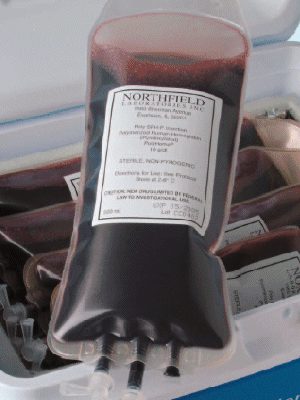Part of a series of articles for National Chemistry Week 2023 on
Unveiling the Surprising Healing Power of Chemistry
Artificial Blood Substitutes
Are we there yet? That question is addressed in an article published in Feb 2023, 'Hemoglobin-Based Oxygen Carriers: Where Are We Now in 2023?'1. The abstract opening is rather downbeat, but notice the optimism in its final sentence:
Artificial blood substitutes represent a groundbreaking application of chemistry in the field of medicine. Natural blood has a variety of functions in the body, including the white blood cells responsible for the immune defense. The artificial blood substitutes are limited in their function. They are designed for the sole purpose of transporting oxygen (and waste carbon dioxide) throughout the body, to mimic the essential oxygen-carrying function of the red blood cells in natural blood. This has enormous potential to provide an unexpected lifeline in emergency situations where conventional blood transfusions are not immediately available or suitable.
Thus, the Healing Power of Chemistry is at the heart of their development, though at present, the goal is unfulfilled. Still, chemistry is being applied, pursuing an outcome for healing when these substitutes serve their crucial role safely and effectively.
The chemistry of artificial blood substitutes revolves around creating compounds that can carry and deliver oxygen to tissues in a manner similar to natural hemoglobin. One of the primary challenges is to develop molecules with a high oxygen-carrying capacity that also remain stable and safe within the body. Early attempts focused on perfluorocarbons (PFCs) and hemoglobin-based oxygen carriers (HBOCs), both of which rely on chemistry for their design and function.
Perfluorocarbons are organic compounds in which hydrogen atoms are replaced by fluorine atoms. Their unique chemistry allows them to dissolve and carry large amounts of oxygen, making them valuable candidates for artificial blood substitutes. They have the advantage of being non-reactive and do not rely on biological processes to function. However, their effectiveness depends on the precise formulation and structural properties of the PFC molecules.
Hemoglobin-based oxygen carriers (HBOCs) are another class of artificial blood substitutes. Here, chemistry comes into play by isolating and modifying hemoglobin molecules found in red blood cells. These modifications aim to enhance the stability of hemoglobin, prevent its breakdown, and control the release of oxygen to tissues. The chemistry behind HBOCs involves cross-linking hemoglobin molecules and encapsulating them within liposomes or other carriers to improve their performance.
One of the key potential advantages of artificial blood substitutes is their compatibility with various blood types, reducing the need for extensive blood typing and matching. Moreover, these substitutes can be stored for longer periods, making them suitable for emergency situations and remote medical facilities where a stable blood supply may not be readily available.
Despite these promising aspects, the development and clinical use of artificial blood substitutes have faced challenges, including concerns about their safety and potential side effects. As such, researchers continue to refine their chemistry, seeking to create substitutes that are both efficient and biocompatible.
In conclusion, the unexpected healing power of chemistry in the development of artificial blood substitutes to transport oxygen underscores the discipline’s ability to address critical medical needs and save lives in emergencies. Chemistry plays a pivotal role in creating molecules and formulations that mimic natural blood, providing an invaluable resource for healthcare professionals working in demanding situations where immediate blood transfusions can be life-saving. However, because their basic limitations, current blood substitutes are better thought of as “oxygen therapeutic agents” (OTAs). As research in this field continues to advance, artificial blood substitutes hold the tantalizing potential to further revolutionize emergency medicine and trauma care.





